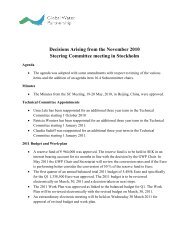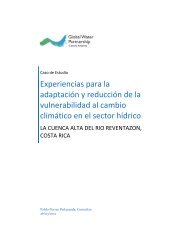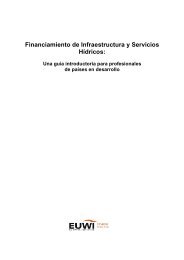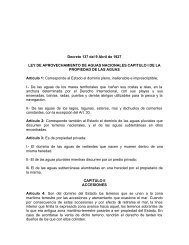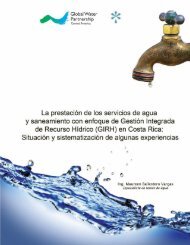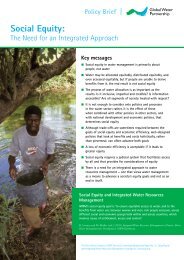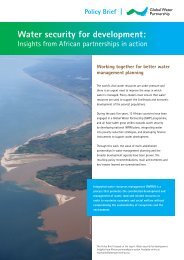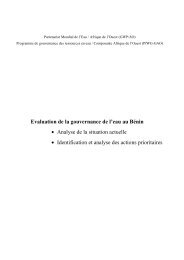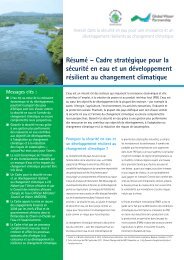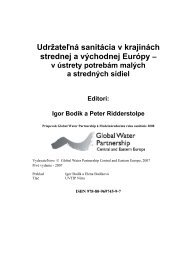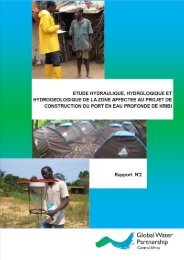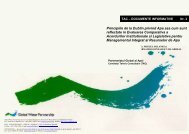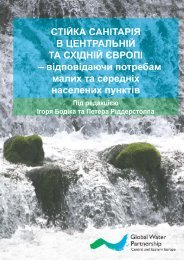Caribbean Water Insight - August 2012 (Vol 3, Issue 2)
Caribbean Water Insight - August 2012 (Vol 3, Issue 2)
Caribbean Water Insight - August 2012 (Vol 3, Issue 2)
Create successful ePaper yourself
Turn your PDF publications into a flip-book with our unique Google optimized e-Paper software.
<strong>August</strong>, <strong>2012</strong><br />
<strong>Vol</strong>ume 3, <strong>Issue</strong> 2<br />
<strong>Caribbean</strong> <strong>Water</strong> <strong>Insight</strong><br />
In This <strong>Issue</strong><br />
Rainwater Harvesting Encourages Sustainability in Rural Communities<br />
US$12.3 Million <strong>Water</strong> Supply Rehabilitation Project to Improve Quality of Life in Guyana<br />
Three <strong>Caribbean</strong> Women Receive International <strong>Water</strong> Law Scholarships<br />
<strong>Caribbean</strong> Youth Speak up on <strong>Water</strong><br />
Women, <strong>Water</strong>, Sanitation and Hygiene in Suriname<br />
See more inside…<br />
Working toward a water secure <strong>Caribbean</strong>
Innovative Agriculture: A Profitable and Sustainable Business<br />
In today’s society when we consider the most<br />
sought after professions, being a farmer or<br />
agriculturalist is not at the top of the list. In the<br />
<strong>Caribbean</strong>, there is an undeniable aging farming<br />
population; highlighting the need for greater<br />
youth involvement in the agriculture sector, the<br />
primary industry of many <strong>Caribbean</strong> countries.<br />
One of the postulations behind the deficit of<br />
young persons passionately and actively seeking<br />
to enter into the field of agriculture is the view<br />
that it isn’t profitable in the long-term. This<br />
according to Mr. Ramgopaul Roop, a Farmer<br />
and Sustainable Agricultural Development<br />
Specialist from Trinidad and Tobago, is a<br />
fallacy. Mr. Roop, now in his early 60’s has been<br />
in the field of agriculture for most of his life and<br />
his work as a farmer is nothing short of a true<br />
success story.<br />
Mr. Roop is the owner of Rocrops Agrotec, a<br />
smallholder family-run farm in central<br />
Trinidad which was established in 1994.<br />
Rocrops Agrotec which became a partner of<br />
GWP-C in March 2011 has been described as<br />
“A diversification dream that has eluded many<br />
agriculturalists.”<br />
The Rocrops farm is quite unique; it once stood<br />
as degraded and acidic sugar cane lands and has<br />
been transformed into a model farm due to the<br />
application of a combination of strategic<br />
planning and innovative agricultural<br />
technologies. The techniques used to manage<br />
the farm include micro-irrigation and recycling<br />
of water; integrated soil and water<br />
management; integrated crop management;<br />
integrated pest management; soil and water<br />
testing; field sanitation and special attention to<br />
post harvest handling techniques.<br />
A key factor in Mr. Roop’s ability to transform<br />
what was once nutrient poor land into a<br />
profitable entrepreneurial success is his vision,<br />
passion and commitment to sustainable<br />
agriculture; notwithstanding the application of<br />
innovative farming techniques.<br />
Mr. Ramgopaul Roop is seen here on his model<br />
farm in Trinidad.<br />
The land which was once laden with low<br />
fertility clay soil now produces an extensive<br />
amount of vegetables and fruit crops. Before<br />
the quest of transforming the land began, the<br />
soil was tested to ascertain its acidity level. The<br />
soil test confirmed that the soil was very acidic<br />
and had to be changed if there was any<br />
prospect of cultivating crops on it. This reality<br />
led to the application of various innovative soil<br />
fertility management techniques.<br />
Story continued on the following page…<br />
1 www.gwp-caribbean.org
Mr. Roop used a combination of methods to fix<br />
the soil; some of these techniques included:<br />
The use of limestone to reduce the soil’s<br />
acidity and improve its structure.<br />
The use of micro-irrigation systems which<br />
helps to save water and energy and even<br />
reduce weeds and diseases.<br />
The application of Integrated Pest<br />
Management (IPM) strategies some of<br />
which included the use of high quality<br />
pesticide-free agricultural products.<br />
The use of integrated soil and water<br />
management applications including the<br />
re-use of water throughout the farm.<br />
The application of fertigation techniques<br />
which refers to the use of fertilisers and<br />
other water-soluble products through an<br />
irrigation system.<br />
The use of organic manure and mulches to<br />
improve the structure and stability of the<br />
soil.<br />
Rocrops Agrotec has established a select<br />
clientele which consists of exporters,<br />
processors, consumers, grocery chains and food<br />
outlets which demand a year round supply of<br />
primary products. Additionally, the farm is<br />
often used as a model demonstration station<br />
and receives frequent visits from local and<br />
regional agricultural students, farmers, and<br />
agriculturalists.<br />
Mr. Roop is seen here on his farm speaking to<br />
Environmental Science students.<br />
The farm’s progress as well as the distinctive<br />
application of integrated water and soil<br />
management techniques applied by Mr. Roop<br />
has not gone unnoticed. In 2001, he won the<br />
Agricultural Entrepreneur of Year Award of<br />
Trinidad and Tobago, which is put on by the<br />
Ministry of Food Production. Within the same<br />
competition Mr. Roop placed first in the<br />
Integrated Agriculture category.<br />
In 2010, Rocrops Agrotec was used as a case<br />
study in Integrated Soil and <strong>Water</strong><br />
Management for Sustainable Agriculture in<br />
Trinidad and Tobago at the Technical Centre<br />
for Agricultural and Rural Development (CTA)<br />
Annual Seminar in Johannesburg, South Africa.<br />
Additionally, Mr. Roop’s work in transforming<br />
what was once sugar cane land into a model<br />
farm has been documented in several research<br />
publications.<br />
Recently, during the month of June, the<br />
GWP-C Secretariat had the opportunity to<br />
visit Mr. Roop’s farm and learnt that Rocrops<br />
Agrotec has been nominated for the Contest of<br />
Successful Cases on Innovation for Family<br />
Agriculture (<strong>2012</strong>). The regional competition<br />
targets the <strong>Caribbean</strong> and Latin American<br />
regions. It is a an initiative led by the Regional<br />
Fund for Agricultural Technology<br />
(FONTAGRO) and supported by the<br />
Inter-American Institute for Cooperation on<br />
Agriculture (IICA) and the Inter-American<br />
Development Bank (IDB).<br />
Story continued on the following page…<br />
2
GWP-C and IICA representatives look on as<br />
Mr. Roop demonstrates various soil and water<br />
management applications used on his farm.<br />
The left image above shows a large pond developed<br />
by Mr. Roop which collects excess water that flows<br />
through the farm. The image on the right is an<br />
electrical pump which helps to drive water that is<br />
recycled throughout the farm.<br />
The overall objective of the contest is to<br />
document successful initiatives on agricultural<br />
innovation with small farmers and other actors<br />
in the agricultural value chain in family<br />
agriculture in Latin America and the <strong>Caribbean</strong><br />
(LAC); and to disseminate these cases<br />
regionally and globally. The three top cases/<br />
nominations in the FONTAGRO competition<br />
will be announced in November of this year.<br />
The competition’s aim to raise awareness about<br />
the importance of investing in agricultural<br />
innovation is precisely what Mr. Roop commits<br />
himself to as he works to encourage greater<br />
youth involvement in agriculture and educate<br />
young farmers on soil and water innovative<br />
techniques.<br />
During the GWP-C Secretariat’s visit to<br />
Rocrops Agrotec, Mr. Roop stressed his goal to<br />
develop incentives and a marketing strategy to<br />
show potential farmers and young persons that<br />
agriculture can be viable and can provide a<br />
good standard of living. He also explained that<br />
the business aspect of agriculture should not be<br />
overlooked and only through agriculture can<br />
future generations be sustainable.<br />
FONTAGRO was created in 1998 with 15 member countries to contribute to poverty reduction<br />
and sustainable management of natural resources.<br />
To learn more about the Fund visit: www.fontagro.org.<br />
<strong>Water</strong> Scholarships<br />
International Scholarships In <strong>Water</strong> Resources Management 2013<br />
The International Centre of Excellence in <strong>Water</strong> Resources Management (ICE WaRM) is<br />
offering a scholarship programme to attract high quality international students to education and<br />
training in <strong>Water</strong> Resources Management. Application Deadline: <strong>August</strong> 31 st , <strong>2012</strong>.<br />
Visit www.icewarm.com for more details.<br />
3 www.gwp-caribbean.org
Rainwater Harvesting Encourages Sustainability in Rural Communities<br />
Trinidad and Tobago, though not considered a<br />
water-scare country by international standards,<br />
is faced with the reality of many of its rural<br />
communities having limited access to a regular<br />
water supply. Persons from rural areas are<br />
often forced to rely heavily on water being<br />
delivered to their homes by trucks; water from<br />
nearby rivers; and in some instances collecting<br />
water from nearby stand-pipes. The water<br />
situation in these communities is also worsened<br />
during the dry season where in some instances<br />
water rationing throughout the country comes<br />
into effect.<br />
The existing state of water access in rural<br />
communities in Trinidad prompted the interest<br />
of the National Institute of Higher Education<br />
Research, Science and Technology (NIHERST)<br />
to develop a project to assist three rural areas -<br />
Toco, Moruga and Barrackpore in becoming<br />
self-sustaining communities by introducing<br />
them to rainwater harvesting and other<br />
sustainable practices to improve their daily<br />
lives.<br />
Rainwater harvesting which refers to the<br />
capture and storage of rainwater for re-use, is a<br />
practice that has been used for centuries for<br />
survival around the world. Within the<br />
<strong>Caribbean</strong> region, there are various islands that<br />
depend heavily on RWH and there are others<br />
like Trinidad and Tobago where it is not<br />
widely used. It is useful to note however, that<br />
prior to public water distribution, RWH was a<br />
common practice in the country but its use has<br />
significantly diminished.<br />
Example of a domestic Rainwater Harvesting (RWH)<br />
system.<br />
Intimately linked to RWH’s limited use in<br />
Trinidad and Tobago is the lack of public<br />
education and community outreach on its<br />
benefits. Furthermore, there is a shortfall in<br />
public information on safe and hygienic RWH<br />
systems. The NIHERST has been able to<br />
address this issue within the framework of its<br />
Rainwater Harvesting project which was<br />
launched this year on World <strong>Water</strong> Day<br />
(WWD), March 22 nd , <strong>2012</strong>.<br />
The NIHERST through partnering with the<br />
Toco Foundation, Global <strong>Water</strong> Partnership-<br />
<strong>Caribbean</strong> (GWP-C), the <strong>Water</strong> Resources<br />
Agency (WRA) of Trinidad and Tobago, and<br />
various community groups, have began to<br />
introduce the concept of RWH as a regular<br />
sustainable activity in the daily lives of residents<br />
in the rural communities of Toco, Moruga and<br />
Barrackpore.<br />
Story continued on the following page…<br />
4
Since March 22 nd , the NIHERST has embarked<br />
on an extensive public education drive on<br />
RWH in the three rural communities, exposing<br />
more than 3500 students from eleven primary<br />
and secondary schools to the concept. Students<br />
have learnt the critical importance of water<br />
conservation and the benefits of RWH through<br />
interactive puppet shows on the relevant topics;<br />
quizzes to assess what they have learnt;<br />
interactive water exhibits; training sessions;<br />
and through other mediums.<br />
Students engaged by interactive water exhibits.<br />
Residents (more than 60) from all three<br />
communities were also exposed to practical<br />
training on the installation of a recommended<br />
RWH system that takes into consideration safe<br />
and hygienic water collection procedures.<br />
Participants were exposed to: all the necessary<br />
material needed to build the system; how to<br />
determine a suitable location for installation;<br />
how to prepare the water tank base as well as<br />
how to install the tank and water level<br />
indicator; among other areas of training.<br />
Scenes from the outreach sessions with<br />
students from the communities of Toco, Moruga<br />
and Barrackpore.<br />
Students are quizzed on what they have learnt by<br />
Ms. Lovaan Superville, Research Officer at the<br />
NIHERST.<br />
<strong>Water</strong> information display at the schools.<br />
Primary school students are entertained by<br />
puppet show on water conservation.<br />
The RWH system being used as the model<br />
within the project is patterned against a system<br />
developed based on existing best practices and<br />
promoted by the GWP-C. To assist<br />
NIHERST in this venture, GWP-C has also<br />
contributed various public education material<br />
that it has developed on RWH including<br />
posters, bookmarks, and technical information<br />
related to the design and installation of the<br />
RWH model it promotes.<br />
Story continued on the following page…<br />
5 www.gwp-caribbean.org
The model which can be adopted by any<br />
water-scarce community is specially designed<br />
to minimise contamination and enhance the<br />
quality of captured and stored rainwater.<br />
What sets the model apart from a typical RWH<br />
system is that it includes a first-flush diverter.<br />
The first-flush diverter is part of the downpipe<br />
configured to remove the initial wash off the<br />
roof so it does not enter the water tank.<br />
This allows the first flow of water containing<br />
roof debris to settle at the bottom of the<br />
downpipe with the cleaner water settling on<br />
top, allowing clean water to enter the tank.<br />
The community members that have received<br />
training on the installation of the RWH system<br />
are expected to be trainers in their respective<br />
communities. With the training received, the<br />
community members are also capable of<br />
advising local businesses in their area on the<br />
proper use and installation of RWH systems.<br />
Rainwater Harvesting (RWH) system installation<br />
at the Rochard Douglas Presbyterian<br />
Primary School in Barrackpore.<br />
The Rochard Douglas Presbyterian Primary School<br />
in Barrackpore, which was selected as the model<br />
disaster shelter.<br />
Example of a first-flush diverter.<br />
Within the project, the Barrackpore<br />
community will benefit from the additional<br />
focus on Renewable Energy and Disaster<br />
Preparedness. One of the schools that received<br />
training in that area was selected as a model<br />
disaster shelter, which will utilise renewable<br />
energy applications.<br />
The renewable energy system consists of solar<br />
panels that will be used to power essential<br />
appliances and fixtures needed in a disaster.<br />
The solar panels have been set-up to power<br />
electricity sockets for lights, a fridge and some<br />
computers. A new RWH harvesting system has<br />
already been installed at the school through the<br />
project and the remainder of the renewable<br />
energy fittings were installed in mid July.<br />
Barrackpore participant preparing the foundation for<br />
the RWH system.<br />
Story continued on the following page…<br />
6
<strong>Water</strong> tank and water level indicator installation.<br />
Installation of the guttering for the RWH system.<br />
Installation of first-flush diverter.<br />
The training received thus far by students and<br />
community members has not been limited to<br />
RWH but also encompasses the overall subject<br />
of water conservation. Students and community<br />
members have learnt the critical importance of<br />
conserving water and have gained a greater<br />
appreciation for the use of RWH as a viable<br />
water supply option.<br />
Rainwater harvesting presents a practical<br />
alternative source of water for rural<br />
communities and the system being used within<br />
the NIHERST project has the advantages of<br />
being low-cost; easy to assemble from locally<br />
available materials; simple to maintain; and<br />
most importantly, supports the protection of<br />
water quality. The NIHERST plans to install<br />
RWH systems in all eleven schools that have<br />
received training by September 1 st , <strong>2012</strong> which<br />
will complete the first pilot project.<br />
Information and photos provided by:<br />
The National Institute of Higher Education<br />
Research, Science and Technology (NIHERST)<br />
Rainwater Harvesting<br />
ToolBox<br />
To learn more about Rainwater Harvesting<br />
(RWH) in the <strong>Caribbean</strong> visit the<br />
GWP-C RWH ToolBox at<br />
www.gwp-caribbean.org.<br />
7 www.gwp-caribbean.org
Media Awards on <strong>Water</strong> Winner Receives Prizes<br />
To raise awareness on sustainable water management in the <strong>Caribbean</strong>, and to commemorate the<br />
United Nations’ World <strong>Water</strong> Day (WWD) <strong>2012</strong> which is celebrated on March 22nd each year,<br />
GWP-C established its first Media Awards on <strong>Water</strong>. The Awards which ran from March 5 th -<br />
April 10 th , <strong>2012</strong> sought to inspire <strong>Caribbean</strong> journalists to report more on regional water issues.<br />
Mr. Shane Hubbard, an Editor and Videographer was declared the winner of the competition with<br />
his television submission which focused on “<strong>Water</strong> and Food Security” in Guyana. He was recently<br />
presented with his winning award and cash prize at a presentation ceremony in Guyana hosted by<br />
the Guyana <strong>Water</strong> Incorporated (GWI) on behalf of GWP-C.<br />
Mr. Shane Hubbard (left) is<br />
presented with his winning award by<br />
the Chairman of the GWI,<br />
Mr. Ramesh Dookhoo (right) on<br />
July 13th, <strong>2012</strong>.<br />
Mr. Emil McGarrell, Permanent<br />
Secretary in the Ministry of<br />
Housing and <strong>Water</strong> gave the<br />
feature address at the ceremony.<br />
Mr. Nigel Niles, Chief Executive<br />
Officer of the GWI provided<br />
background and history on the<br />
GWP-C and its partnership with<br />
the GWI at the Award ceremony.<br />
New Publication<br />
Global <strong>Water</strong> Partnership-<strong>Caribbean</strong><br />
2011 Annual Report<br />
About the Publication | The Annual Report provides a<br />
comprehensive reference to the organisation’s work over<br />
the past year in working towards sustainable solutions to<br />
effective water resources management.<br />
It highlights various collaborative efforts between<br />
GWP-C, its partners and strategic allies. Moreover it<br />
shows how GWPC works to build alliances to strengthen<br />
the Partnership. An overview of the financial condition of<br />
GWP-C is also included in the publication.<br />
Download Annual Report at | www.gwp-caribbean.org<br />
8
US$12.3 Million <strong>Water</strong> Supply Rehabilitation Program to<br />
Improve Quality of Life in Guyana<br />
The quality of life is expected to improve for<br />
the residents of the city of Linden in Guyana<br />
as the Government of Guyana embarks on a<br />
US$12.3 million <strong>Water</strong> Supply Rehabilitation<br />
Program in that area.<br />
Linden, the second-largest town in Guyana<br />
after Georgetown, is the focus of a major water<br />
project being funded by the Inter-American<br />
Development Bank (IDB) called the “Linden<br />
<strong>Water</strong> Supply Rehabilitation Program (LWSRP).”<br />
The Guyana <strong>Water</strong> Incorporated (GWI), the<br />
country’s supplier of water and sanitation<br />
services is the Executing Agency for the next<br />
five years within the framework of the<br />
Program.<br />
One of the prime objectives of the project is to<br />
improve the operational performance of the<br />
Linden water supply system through the<br />
replacement and rehabilitation of its most<br />
critical components. The program’s manager,<br />
Mr. Omar Bissoon has stated that over the<br />
next five years a series of large scale civil<br />
works are expected to take place which will<br />
include the construction of two new water<br />
treatment plants, booster stations, and<br />
reservoirs; the installation of transmission<br />
mains; as well as the rehabilitation of the<br />
distribution system, including replacing<br />
leaking pipelines and service connections.<br />
With the combination of the new treatment<br />
facilities and the reduction of leaks through an<br />
upgrade of the distribution system, Linden<br />
GWI customers will experience improved<br />
water quality as well as higher levels of service.<br />
Within the structure of the Rehabilitation<br />
Program, GWI is also engaging a consultant to<br />
develop a strategy to reduce water loss and<br />
non-revenue water.<br />
The Program’s Manager has also pointed out<br />
that when the new water plants in Linden are<br />
fully operational, customers will enjoy a<br />
higher standard of treated water as the plants<br />
are designed to deliver water quality that<br />
fulfills the World Health Organisation’s<br />
(WHO’s) guidelines.<br />
Apart from the setting up of new water<br />
facilities and systems, another major<br />
component of the project is public education<br />
and community outreach on water<br />
conservation. According to the Program<br />
Manger, “The success of the LWSRP also<br />
depends on the willingness of the GWI Linden<br />
customers to partner with us on water<br />
conservation; protecting freshwater resources<br />
and maintaining safe household water supply.”<br />
Story continued on the following page…<br />
9 www.gwp-caribbean.org
He explained that for customers to enjoy higher levels of service they must avoid wastage. As such,<br />
all the treated water schemes within the Program will be engaged in a water conservation<br />
campaign via mass media and community meetings.<br />
While the new facilities will provide an improved level of safe, potable water in Linden and overall<br />
improvement of the water sector in Guyana, water can still become contaminated if customers are<br />
reluctant to adapt safe habits such as storing water in covered containers and consistently cleaning<br />
black tanks. This is also the reasoning behind the large public education thrust within the LWSRP.<br />
Contributor: Guyana <strong>Water</strong> Incorporated (GWI)<br />
For more information on the Linden <strong>Water</strong> Supply Rehabilitation Project (LWSRP) visit<br />
www.gwiguyana.com.<br />
Guyana <strong>Water</strong> Incorporated Celebrates Ten Years of Progress<br />
GWP-C would like to congratulate its partner, the<br />
Guyana <strong>Water</strong> Incorporated (GWI), on its 10 th<br />
Anniversary.<br />
Over the years GWI, Guyana’s supplier of water and<br />
sanitation services, has and continues to work to improve<br />
access to potable water in Guyana and has made<br />
significant strides in doing this. Access to potable water<br />
in Guyana has risen from 89% in 2000 to 97% in 2009.<br />
GWI has also worked to establish new water treatment facilities in various communities<br />
throughout Guyana. This, according to Guyana’s Minister of Housing and <strong>Water</strong>, the<br />
Honourable Irfaan Ali has tremendously improved the economic, social and education sectors in<br />
the country. GWI has managed to consistently enhance water production sites and improve the<br />
quality of life of Guyanese county-wide in its 10 years of operation.<br />
GWI was formed on May 30 th , 2002 following a merger of the Georgetown Sewage and <strong>Water</strong><br />
Commission (GS&WC) and the Guyana <strong>Water</strong> Authority (GUYWA). The company provides<br />
water service for all of Guyana including large portions of the Hinterland.<br />
For more information on the GWI visit www.gwiguyana.com.<br />
10
<strong>Caribbean</strong> Youth Speak up on <strong>Water</strong><br />
Two <strong>Caribbean</strong> nationals, Shanaz Bacchus of<br />
Barbados and Rolissa Ballantyne of St. Vincent<br />
and the Grenadines had the distinction of being<br />
amongst 80 young people between the ages of<br />
18 to 23 years to participate in the <strong>2012</strong> World<br />
Youth Parliament for <strong>Water</strong> (WYPW). The<br />
WYPW was held within the framework of the<br />
6 th World <strong>Water</strong> Forum (WWF) which took<br />
place in Marseille, France in March of this<br />
year. The Forum brings together thousands of<br />
participants from across the globe such as<br />
politicians; water managers; representatives<br />
from non-governmental organisations (NGOs);<br />
among others.<br />
The CYEN encouraged its members to apply to<br />
attend the WYPW based on information on the<br />
event shared by GWP-C. The WYPW is<br />
considered the largest youth meeting in the<br />
world that focuses specifically on water issues;<br />
and this year’s Parliament saw the participation<br />
of youths from 71 countries and 5 continents, all<br />
committed to local projects in the water sector.<br />
Shanaz Bacchus (from CYEN-Barbados) pointed<br />
out that the WYPW presented an opportunity<br />
for young people to finally have a real place for<br />
their opinions to be heard; and brought<br />
together young persons from around the world<br />
who are motivated to play a part in water<br />
governance. She further explained that during<br />
her time at the WYPW it was obvious that the<br />
youth participants wanted to provide the WWF<br />
with strong recommendations for water issues<br />
and also to commit themselves to engage in real<br />
actions.<br />
The Youth Parliament focused on the theme<br />
“Time for Solutions” and the structure<br />
revolved around that of the 6th WWF.<br />
The three main topics for the Parliament were:<br />
Rolissa Ballantyne (left) of St. Vincent and<br />
the Grenadines and Shanaz Bacchus (right)<br />
of Barbados and are seen here at the World<br />
Youth Parliament for <strong>Water</strong> in Marseille,<br />
France in March <strong>2012</strong>.<br />
Shanaz Bacchus and Rolissa Ballantyne are<br />
both members of the <strong>Caribbean</strong> Youth<br />
Environment Network (CYEN), the oldest,<br />
largest and most active youth organisation that<br />
focuses on environment and sustainable<br />
development in the <strong>Caribbean</strong> region. The<br />
CYEN became a partner organisation of Global<br />
<strong>Water</strong> Partnership-<strong>Caribbean</strong> (GWP-C) in<br />
June 2006.<br />
1. Access to <strong>Water</strong> and Sanitation<br />
2. Climate Change and Natural Disasters<br />
3. <strong>Water</strong> Basin Governance<br />
Ballantyne (from CYEN-St. Vincent and the<br />
Grenadines) recounted that every day was<br />
demanding as the youth participants tirelessly<br />
worked to prepare a Charter and a Declaration<br />
which had to be presented at the major event -<br />
the 6 th WWF.<br />
Story continued on the following page…<br />
11 www.gwp-caribbean.org
The Charter stipulates the Parliament’s<br />
objectives and rules of governance. It therefore<br />
covered details related to membership, the<br />
organs and internal regulations of the<br />
Parliament.<br />
The Declaration on the other hand, detailed the<br />
commitment of the young parliamentarians in<br />
finding solutions related particularly to global<br />
water access and sanitation, climate change and<br />
water governance. The document clearly<br />
outlined the Parliament’s major concerns and<br />
recommendations. Some of the major concerns<br />
by the youth included the lack of awareness at<br />
all levels on issues such as climate change,<br />
natural disasters, and depletion of potable water<br />
resources, among many others.<br />
The youth also stated their concern for good<br />
governance and stakeholder participation at all<br />
levels for equitable and inclusive water<br />
distribution. Within the Declaration,<br />
representatives committed to various<br />
responsibilities in their respective regions.<br />
At the WYPW, Bacchus and Ballantyne were<br />
advocates for water issues in the <strong>Caribbean</strong>.<br />
Within the framework of the Parliament, they<br />
were able to make the link between climate<br />
change and the impacts on Small Island<br />
Developing States (SIDS); and also raised issues<br />
related to water availability and access in the<br />
<strong>Caribbean</strong>. They also proposed that Integrated<br />
<strong>Water</strong> Resources Management (IWRM) be a<br />
central pillar in national planning especially in<br />
<strong>Caribbean</strong> countries which are water scarce.<br />
The <strong>Caribbean</strong> participants explained that the<br />
youth of Central America and the <strong>Caribbean</strong>,<br />
have pledged to create the first School for<br />
<strong>Water</strong> at the regional level, where children will<br />
be educated on topics related to water<br />
governance.<br />
Additionally, the participants committed to<br />
promoting the creation of an ecological<br />
corridor in Central America in collaboration<br />
with civil societies, governments and the<br />
private sector. Bacchus of Barbados was<br />
elected as the regional support for the<br />
<strong>Caribbean</strong> and Central America.<br />
The St. Vincent and the Grenadines<br />
representative explained that the discussions<br />
on major concerns for the preparation of the<br />
Declaration helped her to better understand<br />
how privileged the citizens of her country of<br />
St. Vincent are to have access to running<br />
water. Furthermore, it helped her better<br />
understand how to deal with the water<br />
management issues faced by her country.<br />
In major decision making on water and<br />
developmental issues across the globe, the<br />
youth are often important stakeholders that<br />
are not readily given a voice in such<br />
discussions. The World Youth Parliament for<br />
<strong>Water</strong> presented an invaluable chance for<br />
young people from various parts of the world<br />
including the <strong>Caribbean</strong>, to highlight their<br />
commitment to water, develop an<br />
understanding of water issues, and also<br />
contribute to the World <strong>Water</strong> Forum with<br />
solutions based on their initiatives and their<br />
projects.<br />
With the knowledge gained from their<br />
participation at the <strong>2012</strong> WYPW, Bacchus<br />
and Ballantyne both plan to share their<br />
experiences with other youth in the region to<br />
engage them on critical water and<br />
development issues.<br />
Information and photo provided by:<br />
The <strong>Caribbean</strong> Youth Environment Network<br />
(CYEN)<br />
For more information on the above listed documents prepared at the WYPW, please go to:<br />
www.cyen.org/documents/resources.php<br />
12
Photo of the <strong>Issue</strong><br />
Two young boys are seen here bathing in a waterfall called the “Corriente de Vallejuelo” in<br />
San Juan de La Maguana in the south of the Dominican Republic.<br />
Photo submitted by GWP-C Partner: Asociacion Vigilantes de la Calidad del Agua (AVA)<br />
based in the Dominican Republic.<br />
Photographer: Ricardo Rojas<br />
13 www.gwp-caribbean.org
GWP IWRM ToolBox: Academically Valuable and Real-World Practical<br />
It has been 10 years since the Integrated <strong>Water</strong> Resources<br />
Management (IWRM) ToolBox was developed by the<br />
Global <strong>Water</strong> Partnership (GWP) to increase knowledge<br />
sharing on an integrated approach to water resources<br />
management.<br />
IWRM ToolBox Training<br />
across the Globe<br />
One of the indications of its success during the past 10 years has<br />
been the many IWRM knowledge materials that have been<br />
published, and taught, by international policy and advocacy<br />
organisations. Some of these organisations include the United<br />
Nations Development Programme (UNDP); Cap-Net; the United<br />
Nations Environment Programme (UNEP); UN-<strong>Water</strong>; the DHI<br />
group; the Stockholm International <strong>Water</strong> Institute (SIWI);<br />
among others.<br />
IWRM’s adaptability is seen in the fact that real-world<br />
challenges have brought about new tools. In 2010 for example,<br />
the GWP ToolBox was upgraded with new tools on policies for<br />
adapting to climate change; tools on the concepts of water<br />
footprint and virtual water; and a tool addressing the<br />
relationship between IWRM and infrastructure. In <strong>2012</strong>, further<br />
tools are under revision; namely those dealing with financial<br />
frameworks and economic instruments.<br />
One outcome of the IWRM Toolbox has been its adoption into<br />
the curriculum of university education. There are already several<br />
universities across the globe that use the IWRM Toolbox in<br />
advanced education. For example, in a Master’s program in a<br />
West African network of eight universities and in a Southern<br />
African program in 16 countries, the IWRM ToolBox structure<br />
is used in their curricula.<br />
Story continued on the following page…<br />
14
The goal is to increase the use of the Toolbox<br />
in education and research institutions as well as<br />
illustrate application of the Toolbox for<br />
training and capacity building programs.<br />
The GWP has already successfully done this in<br />
countries such as Ghana, Armenia, China; and<br />
regions such as Central Asia, and Eastern and<br />
Central Europe.<br />
Other universities in countries such as Ethiopia,<br />
Hungary, and Nanjing Province in China are<br />
using the ToolBox; and there has been some<br />
usage of the ToolBox in tertiary level<br />
institutions in the <strong>Caribbean</strong> region.<br />
Furthermore, a growing number of<br />
international organisations and nongovernmental<br />
organisations (NGOs) use the<br />
ToolBox for capacity building programs and<br />
training.<br />
The integration of the ToolBox in university<br />
education has inspired the GWP to launch a<br />
planned initiative to expand the use and<br />
accessibility of the ToolBox in universities in<br />
the developing world. The GWP intends to<br />
work with Partners to facilitate the growth of<br />
IWRM Knowledge Centers so that the Toolbox<br />
is used in universities for knowledge exchange<br />
and capacity development on priority water<br />
needs.<br />
The aim of the initiative is for the IWRM<br />
Knowledge Centers to be national and regional<br />
universities and other educational institutions<br />
interested in promoting IWRM and committed<br />
to sharing water knowledge and building<br />
capacity. The Centers are also expected to play<br />
an important role in policy support for<br />
government agencies.<br />
Ultimately, the GWP IWRM ToolBox is<br />
available for Partners of the GWP network and<br />
for everyone working in development.<br />
Promoting its use in educational institutions<br />
will ensure its benefits from the latest thinking<br />
in the world of water resources management<br />
and at the same time guarantee that the tools<br />
are applied by present and future water<br />
professionals.<br />
Contributor: The Knowledge Management<br />
Team of the Global <strong>Water</strong> Partnership (GWP)<br />
For more on the IWRM ToolBox visit<br />
www.gwptoolbox.org.<br />
Engaging Youth in the Environment<br />
A young boy gets assistance with planting a<br />
tree during the Fondes Amandes Community<br />
Re-forestation Project’s (FACRP’s) World<br />
Biodiversity Day Caravan in the community of<br />
Tamana in Trinidad.<br />
Photo submitted by GWP-C Partner: The Fondes Amandes Community Re-forestation Project (FACRP)<br />
based in Trinidad and Tobago.<br />
Photo taken by: Ms. Skye Hernandez (Administrator, FACRP)<br />
15 www.gwp-caribbean.org
<strong>Water</strong> Resources Management and the St. Patrick’s Disaster in Grenada<br />
Grenada, like other tropical countries, is prone<br />
to the impacts of natural hazards which can<br />
impair a country’s water supply and<br />
distribution. Such a situation occurred on the<br />
evening of April 20 th , <strong>2012</strong>, when the parish of<br />
St. Patrick experienced heavy incessant rainfall.<br />
The downpour which continued into the early<br />
morning, caused massive land-slides and moved<br />
boulders, rocks, sand and silt downstream. The<br />
high rainfall which caused massive erosion and<br />
heavy siltation of the river channels, restricted<br />
the two dams in the area from supplying water<br />
to the major water treatment plant in<br />
St. Patrick.<br />
Residents were completely unprepared for the<br />
local disaster and did not withhold their<br />
criticism of the National <strong>Water</strong> and Sewerage<br />
Authority (NAWASA), Grenada’s national<br />
supplier of water and sanitation services.<br />
The St. Patrick residents blamed the<br />
Authority for not carrying out mitigation<br />
measures to minimise or prevent the<br />
occurrence of such a disaster.<br />
With no water flowing into the treatment plant,<br />
approximately 12,000 persons in the<br />
communities which it serves, were left without<br />
water for five days; a record in service<br />
disruption for such an isolated event.<br />
Affected dam in St. Patrick.<br />
Amidst the criticism by residents, the<br />
NAWASA saw the disaster as a unique<br />
opportunity to engage the affected communities<br />
and country as a whole in looking at the<br />
benefits of an Integrated <strong>Water</strong> Resources<br />
Management (IWRM) approach.<br />
Images of one of the dams in St. Patrick completely<br />
covered by rock and silt.<br />
IWRM can be described as a holistic approach<br />
to managing water that takes into<br />
consideration that different uses of water are<br />
interdependent. This means that water<br />
allocations and management decisions consider<br />
the effects of each use on the other. The<br />
approach is also grounded in the understanding<br />
that water resources are an integral component<br />
of the ecosystem, a natural resource, and a<br />
social and economic good.<br />
Story continued on the following page…<br />
16
In considering an IWRM approach, the<br />
NAWASA sought to involve the affected<br />
communities in rehabilitating the damaged<br />
dams. The St. Patrick’s parish proposed a<br />
community meeting with twenty-one nongovernmental<br />
organisations (NGOs) from the<br />
area which saw the planning of approaches for<br />
assisting with the post-disaster restoration and<br />
recovery efforts. These stakeholders were able<br />
to highlight to the NAWASA the need for the<br />
development of viable long-term solutions to<br />
alleviate possible future occurrences of a similar<br />
nature.<br />
A church youth group in the community also<br />
took action through voluntary assistance. Over<br />
twenty youths from the church group, 8 of<br />
which were females, braved the treacherous<br />
climb to the dam and laboured for six hours in<br />
digging out the debris deposited by the river<br />
into the dam enclosure. The leader of the group<br />
expressed enthusiasm on behalf of the<br />
volunteers, and indicated that the effort had<br />
heightened their awareness of the challenges<br />
faced in managing water resources and sparked<br />
their interest in learning more.<br />
Community members work to clear the dams.<br />
The first clearance attempt by the volunteers.<br />
The local disaster has helped to build awareness<br />
and understanding of the values and benefits of<br />
IWRM and planning and it has also made the<br />
staff of the NAWASA and the Grenadian<br />
consumer more aware of the vulnerability of the<br />
<strong>Water</strong> Authority’s facilities to climate<br />
variability.<br />
In light of what happened in St. Patrick, the<br />
NAWASA has taken steps towards preventing<br />
re-occurrences of a similar nature and as a<br />
short-term solution has created a protection<br />
mechanism for the rosehead of the dams to avoid<br />
blockage.<br />
The Authority continues to seek alternative<br />
mitigation measures to reduce the vulnerability<br />
of its facilities to natural disasters; and is in the<br />
process of developing long-term strategies and<br />
policies to address these threats and issues. One<br />
such strategy has been the preparation of<br />
drought and disaster management plans.<br />
<strong>Vol</strong>unteers working together to clear the<br />
dams.<br />
Contributor: The National <strong>Water</strong> and Sewerage<br />
Authority (NAWASA)<br />
17 www.gwp-caribbean.org
Women, <strong>Water</strong>, Sanitation and Hygiene in Suriname<br />
Access to a safe water supply, good sanitation and<br />
hygiene are essential for a healthy and decent<br />
quality of life. However, many rural communities<br />
throughout the world have limited access to a safe<br />
and reliable water supply and suitable sanitation<br />
facilities. Moreover, women and girls are deemed<br />
the most affected stakeholders in terms of water,<br />
sanitation and hygiene. This is because<br />
traditionally they have been associated with the<br />
responsibility for the water supply, sanitation and<br />
hygienic maintenance of the home.<br />
In the <strong>Caribbean</strong> region there are various<br />
non-governmental organisations (NGOs) that are<br />
cognizant of women’s central role in the provision<br />
and safeguarding of water and their vital role in<br />
terms of sanitation and hygiene upkeep. One such<br />
organisation is the National Women’s Movement<br />
(NVB) in Suriname who became partners of the<br />
Global <strong>Water</strong> Partnership-<strong>Caribbean</strong> (GWP-C) in<br />
<strong>August</strong> 2011.<br />
The NVB is a NGO focused on the areas of<br />
economic empowerment; capacity building of<br />
women's organisations; legal aid; housing; and<br />
health. In addition, the organisation is the<br />
Coordinator of the National Steering Group on<br />
<strong>Water</strong>, Sanitation and Waste Management in<br />
Suriname and has implemented several water and<br />
sanitation programmes particularly for women in<br />
the less developed areas in the interior of<br />
Suriname.<br />
<strong>Water</strong> Supply<br />
In 2006, the National Women’s Movement<br />
(NVB) in collaboration with World <strong>Water</strong>net<br />
and the Suriname <strong>Water</strong> Company executed a<br />
drinking water programme in the hinterland<br />
of Suriname. Through the programme, water<br />
installations were set-up in three villages and<br />
to date an estimated two thousand villagers<br />
now have access to clean drinking water in the<br />
villages of Asindonhopo, Bendekonde and<br />
Akisiamau.<br />
Asindonhopo<br />
Bendekonde<br />
Here’s a look at three initiatives spearheaded by<br />
the NVB aimed at improving and building<br />
awareness on water management, sanitation and<br />
hygiene for women and other stakeholders in<br />
Suriname:<br />
Akisiamau<br />
Story continued on the following page…<br />
18
Eco-Sanitation<br />
From 2007 to 2010 the NVB coordinated a<br />
National Consortium on <strong>Water</strong>, Eco-sanitation<br />
and Waste Management; executing the ISSUE-2<br />
Programme which was about empowering local<br />
stakeholders to develop and implement practical<br />
solutions to overcome urban environmental<br />
problems, and meet the Millennium Development<br />
Goals (MDGs). This programme was supported<br />
by WASTE, World <strong>Water</strong>net, Women for <strong>Water</strong><br />
Partnership and the United Nations<br />
Environmental Programme. The eco-sanitation<br />
project was implemented in six villages in the<br />
upper Suriname region in the interior.<br />
The launch of the first Urine Diverting Dry<br />
Toilet (UDDT or eco-toilet) took place in 2009,<br />
with the involvement of a local dignitary, who<br />
assisted with awareness raising on this subject.<br />
The concept of this system is that urine and other<br />
excrements are stored separately above the<br />
ground.<br />
In the beginning of the Programme there were<br />
social and cultural constraints. However, the<br />
eco-toilet became a huge sanitation solution for<br />
the women and elderly in the hinterland. With its<br />
introduction, the women in the villages are not<br />
forced to go to the bushes and rivers when nature<br />
calls; instead they can use the facility in the<br />
privacy if their homes.<br />
Jolina, a blind woman who lived with her sick<br />
mother in the village of Akisiamau, got her<br />
eco-toilet in 2009. For her and her mother this<br />
was a relief and a way of being independent and<br />
comfortable.<br />
Majolina, a mother and grandmother, is also<br />
very satisfied with her own eco-toilet and finds<br />
it very convenient. Majolina is also the Chair<br />
of a local women’s organisation “Hoi Tanga”<br />
that strongly advocates for development of the<br />
community.<br />
Majolina and her family.<br />
Peer to Peer <strong>Water</strong>, Sanitation and Hygiene<br />
Training<br />
From March 1 st to 3 rd , <strong>2012</strong>, the <strong>Water</strong> and<br />
Sanitation Unit of the NVB in collaboration<br />
with World <strong>Water</strong>net, organised a Peer to<br />
Peer <strong>Water</strong>, Sanitation and Hygiene (WASH)<br />
Training at two primary schools, in the areas<br />
of Godo and Djumu, in the Suriname interior.<br />
This model is based on the fact that people<br />
will not only change based on what they<br />
know, but also through the opinions and<br />
actions of their trusted peers. The main goal of<br />
the training was to raise awareness at the<br />
schools on the importance of water, sanitation<br />
and hygiene. Through this project, the NVB is<br />
thriving to create a “Life-Long Good Hygiene<br />
Habit” amongst the pupils.<br />
Story continued on the following page…<br />
Jolina<br />
19 www.gwp-caribbean.org
Three teachers and nine peer educators participated in<br />
this training. With the training received, the teachers<br />
and peer educators can now organise educational<br />
activities for both children and adults in their<br />
communities and share knowledge on water, sanitation<br />
and hygiene.<br />
Contributor: The National Women’s Movement<br />
Pupils and teachers from the schools O.S.<br />
Godo and EBGS Djumu.<br />
Professional Certificate in Strategic <strong>Water</strong> Planning<br />
The International Centre for Parliamentary Studies (ICPS) is offering a course in Strategic <strong>Water</strong><br />
Planning from December 10th - 13th, <strong>2012</strong> in London. Course participants are expected to develop<br />
essential skills for understanding regulation, governance and sustainability of the water sector.<br />
Early Registration: <strong>August</strong> 21st, <strong>2012</strong>.<br />
Visit www.strategicwater.parlicentre.org for more details.<br />
Upcoming Events<br />
GWP Consulting Partners Meeting <strong>2012</strong>: “Beyond Rio+20: <strong>Water</strong> as a Catalyst for<br />
Climate-Resilience Development” - <strong>August</strong> 26 th , <strong>2012</strong>, Stockholm<br />
World <strong>Water</strong> Week: “<strong>Water</strong> and Food Security” - <strong>August</strong> 26 th - 31 st , <strong>2012</strong>, Stockholm<br />
21 st Annual <strong>Caribbean</strong> <strong>Water</strong> and Wastewater Association (CWWA) Conference<br />
and Exhibition: “<strong>Water</strong> and Waste Management in the <strong>Caribbean</strong>: Real Strategies and<br />
Solutions” - October 1 st - 2 nd , <strong>2012</strong>, Bahamas<br />
8 th <strong>Caribbean</strong> High Level Session (HLS) Ministerial Forum: October 4 th - 5th, <strong>2012</strong>,<br />
Bahamas<br />
Inter-American <strong>Water</strong> Day - October 6 th , <strong>2012</strong>.<br />
20
Three <strong>Caribbean</strong> Women Receive International <strong>Water</strong> Law Scholarships<br />
1 2 3<br />
1. Alana Lancaster - Environmental Lawyer, Lecturer and Natural Resource Management Specialist<br />
Nationality: Barbadian<br />
2. Judy Daniel - Attorney-at-Law and Environmental Management Specialist<br />
Nationality: Trinidadian<br />
3. Nadia Joseph - Geography Teacher and Post-Graduate Student in <strong>Water</strong> and Environmental Management<br />
Nationality: St. Lucian<br />
Three <strong>Caribbean</strong> nationals, Ms. Judy Daniel of<br />
Trinidad and Tobago; Ms. Nadia Joseph of<br />
St. Lucia; and Ms. Alana Lancaster of Barbados<br />
were among 30 persons from across the globe to<br />
receive scholarships to undertake an<br />
International <strong>Water</strong> Law (IWL) course at the<br />
University of Dundee in Scotland from June 11 th<br />
to 29 th , <strong>2012</strong>.<br />
The IWL Scholarship Programme is an<br />
initiative of the Global <strong>Water</strong> Partnership<br />
(GWP) and the United Nations Educational,<br />
Scientific and Cultural Organisation (UNESCO)<br />
IHP-HELP Centre for <strong>Water</strong> Law, Policy and<br />
Science at the University of Dundee.<br />
Ms. Daniel, Ms. Joseph and Ms. Lancaster were<br />
eligible to apply for the IWL scholarship due to<br />
their affiliation with the GWP-C. All three<br />
women are members of partner organisations of<br />
the GWP-C.<br />
GWP-C had the opportunity to communicate<br />
with the three participants following the<br />
completion of their training in Dundee and here<br />
is some of what they had to say about the<br />
experience:<br />
Nadia Joseph (St. Lucia)<br />
Ms. Nadia Joseph of St. Lucia explained that the<br />
training in International <strong>Water</strong> Law (IWL)<br />
would assist her in her studies as she is<br />
currently pursuing a Master’s degree in <strong>Water</strong><br />
and Environmental Management. She pointed<br />
out how pertinent the course was to her studies<br />
as she came to realise that proper water<br />
management requires good legislative and<br />
policy knowledge.<br />
She explained that as a Geography teacher, she<br />
can use the knowledge from the training to<br />
educate her students on the critical importance<br />
of water.<br />
Ms. Joseph pointed out that one of the most<br />
important lessons learnt at her training in<br />
Dundee was the increasing need to have persons<br />
aware of the current status of water and how<br />
one can ensure that water, which has no<br />
substitutes, is protected.<br />
Feature continued on the following page…<br />
21 www.gwp-caribbean.org
She also noted that the training showed her how<br />
fortunate her country of St. Lucia was in<br />
relation to critical issues such as transboundary<br />
watercourses as transboundary water laws are<br />
not applicable in the <strong>Caribbean</strong> region.<br />
She further stated that the issues of upstream<br />
and downstream are still evident and persons<br />
must be aware that everyone has a right to<br />
water.<br />
Ms. Joseph stressed how beneficial the training<br />
in IWL was to her but suggested that the<br />
course could be extended to three weeks instead<br />
of two. She pointed out that the two week<br />
course was very demanding and embodied a lot<br />
of information which is initially not easily<br />
understood by persons with a non-law<br />
background.<br />
Another suggestion by Ms. Joseph to improve<br />
the programme was the idea of having small<br />
tasks assigned to persons to discuss and debate.<br />
She said that this would better prepare course<br />
participants for the formal assessments such as<br />
oral law pleading, written pleading and a<br />
research paper. She pointed out that being<br />
someone with no prior training in law, there<br />
was a lot of work to be covered for her to be<br />
sufficiently prepared for the course<br />
assessments.<br />
Judy Daniel (Trinidad and Tobago)<br />
Ms. Judy Daniel, Attorney-at-Law and<br />
Environmental Management Specialist shared<br />
that the course provided an invaluable<br />
opportunity to expand her network of water<br />
professionals.<br />
When asked about ways in which the IWL<br />
programme can be improved, Ms. Daniel<br />
suggested that the course take on a more<br />
practical and cross-cutting approach to address<br />
more areas in IWL such as governance issues,<br />
involvement of local communities, regulatory<br />
arrangement, small island states; among other<br />
issues.<br />
Ms. Daniel pointed out that if the<br />
objective of the IWL course was to certify an<br />
understanding of the IWL Convention to<br />
non-lawyers, then that objective was met.<br />
Alana Lancaster (Barbados)<br />
Ms. Alana Lancaster, Environmental Lawyer<br />
and Lecturer in Environmental and<br />
International Environmental Law stated that<br />
the IWL workshop provided an excellent<br />
opportunity for her to build her capacity in the<br />
discipline at one of the leading centres of<br />
excellence in water law in the world.<br />
She explained that the overall experience at<br />
Dundee was rich and rewarding. Ms. Lancaster<br />
said that the training course included the<br />
participation of a wide-cross section of<br />
academics and professionals which enabled her<br />
to expand her knowledge in the area of<br />
international water law as well as to consolidate<br />
research she is currently undertaking in the area<br />
of international environmental law.<br />
Ms. Lancaster pointed out that many of the<br />
programme’s participants were drawn from<br />
various regions in the world, and from a range<br />
of professional backgrounds concerned with the<br />
management and administration of water<br />
resources. This diversity and inter-disciplinarity<br />
she said provided unique, as well as shared<br />
knowledge on the topic.<br />
She noted that lessons learnt from her IWL<br />
training will be shared in academic and<br />
professional fora in the <strong>Caribbean</strong> region and at<br />
The University of the West Indies (UWI),<br />
Cavehill Campus where she lecturers. This<br />
would include the Faculty of Law and the<br />
Centre of Resource Management and<br />
Environmental Studies (CERMES) at the UWI.<br />
22
<strong>Caribbean</strong> <strong>Water</strong> <strong>Insight</strong><br />
Special Thanks to:<br />
The National Institute of Higher Education Research, Science and Technology (NIHERST)<br />
Rocrops Agrotec<br />
Guyana <strong>Water</strong> Incorporated (GWI)<br />
The <strong>Caribbean</strong> Youth Environment Network (CYEN)<br />
International <strong>Water</strong> Law Scholarship Recipients -<br />
Ms. Judy Daniel, Ms. Alana Lancaster and Ms. Nadia Joseph<br />
The Knowledge Management Team of<br />
the Global <strong>Water</strong> Partnership (GWP)<br />
The National <strong>Water</strong> and Sewerage Authority (NAWASA)<br />
The National Women’s Movement<br />
————————————————————————————————————————--<br />
Photo Credits<br />
Asociacion Vigilantes de la Calidad del Agua (AVA)<br />
Cover Page<br />
Handbook on Rainwater Harvesting for the <strong>Caribbean</strong> by the<br />
<strong>Caribbean</strong> Environmental Health Institute (CEHI)<br />
Page 4<br />
Guyana <strong>Water</strong> Incorporated (GWI)<br />
Page 8<br />
Mr. Ricardo Rojas (Photographer)<br />
Page 13<br />
Fondes Amandes Community Re-forestation Project (FACRP)<br />
Page 15<br />
CONTACT US<br />
GWP-C Secretariat, c/o NIHERST, 43-45 Woodford Street, Port-of-Spain, Trinidad, W.I.<br />
Tel: +868 622 3117, Fax: +868 622 1589, E-mail: info@gwp-caribbean.org<br />
Website: www.gwp-caribbean.org



